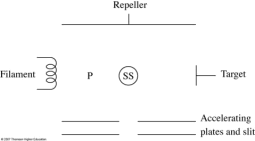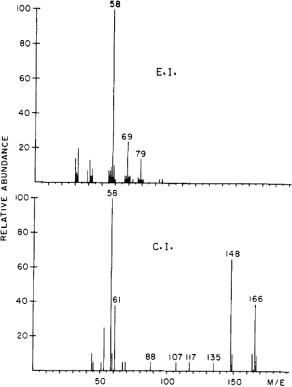CHE401 Coursework 1 – Mass Spectrometry
Hello, dear friend, you can consult us at any time if you have any questions, add WeChat: daixieit
CHE401 Coursework 1 - Mass Spectrometry
This coursework is an assessed component of the module and constitutes to 40% of the total module mark.
Submission deadline: 9:00am, 30th Oct 2023
Answer all questions
Question 1.
i. How do gaseous and desorption sources in Mass Spectrometry differ?
ii. What are the advantages of each? [5 marks]
Question 2.
The following figure is a simplified diagram of a commercially available electron impact source. [ 5 marks]

i. What voltage must be applied between the filament and target so that electrons interacting with molecules at the point marked SS (sample source) will have 70 eV of kinetic energy? [3 marks]
ii. What will happen to a molecule that diffuses toward the filament and is ionized at point P? [2 marks]
Question 3.
When a magnetic sector instrument was operated with an accelerating voltage of 3.00×103 V, a field of 0.126 T was required to focus the CH4(+) on the detector. [10 marks]
i. What range of field strengths would be required to scan the mass range between 16 and 250, for singly charged ions, if the accelerating voltage is held constant? [5 marks]
ii. What range of accelerating voltages would be required to scan the mass range between 16 and 250, for singly charged ions, if the field strength is held constant? [5 marks]
Question 4.
Give the molecular formula, exact mass and expected mass of the following compounds: caffeine, menthol and theobromine. [15 marks]
Provide a suitable method which you would use to analyse a mixture of the above 3 compounds? [1 mark]
|
Caffeine |
Menthol |
Theobromine |
|
MF:
Exact mass:
Experimental mass: |
MF:
Exact mass:
Experimental mass: |
MF:
Exact mass:
Experimental mass: |
[3 X 2 marks]
Explain why the previous method used is not suitable for the following 3 compounds and provide a suitable method. [2 marks]

[3 x 2 marks]
Question 5.
What mass differences can just be resolved at m values of 100, 500, 1500, 3000 and 5000 if the mass spectrometer has a resolution of (a) 500, and (b) 5000? [10 marks]
Question 6.
The following figure shows the mass spectra of the same compound from an EI ionization source and a CI source (from J. Amer. Chem. Soc., 1970, 92, 1590- 1597). [20 marks]

i. Which mass spectrum would be better for determining the molecular mass of the compound? Why? [2 marks]
ii. Which mass spectrum would be better for determining the chemical structure? Why? [2 marks]
iii. The electron impact source was a pulsed source used with a TOF mass analyser. If the flight tube were 1.0 m long and the accelerating voltage were 3000 V, what would the flight time be for the ion at m/z = 58? [3 marks]
For two ions of m/zvalues m1 /z and m2 /z, derive an equation for the difference in flight times ΔtF as a function of the two masses, the charges, and the accelerating voltage. [3 marks]
iv. To get more structural information, the compound was subjected to tandem mass spectrometry. Which ionization source, electron impact or chemical ionization, would be more suitable for this purpose? Why? [2 marks]
v. Using the ionization source chosen in part (f), describe the types of mass spectra that could be obtained from an MS/MS experiment by:
i. Holding the first mass analyser constant and scanning the second analyser ii. Scanning both analyzers with a small m/z offset between them
iii. Scanning the first analyser while holding the second analyser constant
iv. Scanning the second mass analyser for every mass selected by the first analyser.
In your answer, use features of the mass spectrum to illustrate your description. [8 marks]
Question 7.
The following figure shows the mass spectrum of 3-methyl and 4-methyl-2-pentanone from an EI source. Assign the spectrum to each molecule with explanation on the formation mechanism of fragment ions. [10 marks]

2023-10-17